Thousands of species were described for the first time by scientists in 2012. Some of these were ‘cryptic species’ that were identified after genetic analysis distinguished them from closely related species, while others were totally novel. Either way, here are some of the “new species” highlights from 2012.
Immediately below is a gallery of the discoveries. These include captions. You can use the arrow keys on your keyboard to navigate through the images. “n” also advances through images, while “p” goes to the previous image. Use “c” or click on the background to close the window.
Below the gallery are more in-depth descriptions of the discoveries, with links to individual articles which usually include the reference to the academic paper that describes each species for the first time.
 Kayan loris. Photo by Ch’ien Lee |
In December researchers described three new species of slow loris in the American Journal of Primatology. The species were identified after genetic and morphological work on Nycticebus menagensis, a primate that is imperiled by the pet trade. The new species are Nycticebus bancanus, Nycticebus borneanus, and Nycticebus kayan. All are from Borneo.

The Spangled Darter (Etheostoma obama) from Tennessee is named after President Barack Obama. Illustration by Joe Tomelleri
In November, scientists named five newly discovered species of fish after former and current U.S. political leaders, including President Barack Obama, Bill Clinton, Al Gore, Jimmy Carter, and Teddy Roosevelt. The descriptions were published in in the journal the Bulletin of the Alabama Museum of Natural History. The fish are all species of darter, a group that is found widely in the United States. The species were identified after research on the Speckled Darter (Etheostoma stigmaeum) concluded that it could be divided into nine separate species, five of which are now named after U.S. leaders. These include the Spangled Darter (Etheostoma obama) from Tennessee; the Cumberland Darter (Etheostoma gore) and the Bluegrass Darter (Etheostoma jimmycarter) from Tennessee and Kentucky; the Highland Darter (Etheostoma teddyroosevelt) from Missouri, Arkansas, Kansas and Oklahoma; and the Beaded Darter (Etheostoma clinton) from Arkansas.

A live Imantodes chocoensis. Its head is about the size of an American penny. Photo by Omar Torres-Carvajal et al.
In November herpetologists writing in Zookeys described Imantodes chocoensis, a new species of blunt-headed vine snake from the Chocó Forests in northeastern Ecuador. The new species is distinct due to its lack of a loreal scale—a large scale on its head that all other blunt-headed vine snakes possess. Interestingly, the new species closest relative, the Amazon Basin tree snake (Imantodes lentiferus), is actually a mountain chain away: it’s found on the other side of the Andes in the Amazon rainforest. All blunt-headed vine snakes are night hunters, using their big eyes to track down lizards and frogs.
 The possibly extinct Lucihormetica luckae, which oddly resembles a Jawa from Star Wars. Photo courtesy of Vršanský et al. |
In 2010 Peter Vršanský and colleagues encountered a light-producing cockroach, Lucihormetica luckae, in Ecuador, but the species wasn’t described until this year when its description was published in the journal Naturwissenschaften. Notably the roach represents the only known case of mimicry by bioluminescence in a land animal. Like a venomless king snake beating its tail to copy the unmistakable warning of a rattlesnake, Lucihormetica luckae’s bioluminescent patterns are nearly identical to the poisonous click beetle, with which it shares (or shared) its habitat. Sadly the species may already be extinct: it may have been wiped out by the 2010 eruption of Tungurahua Volcano, its only known habitat. No individuals have been seen since.

Male specimen of new species: Iridopelma oliveirai. Photo courtesy of R. Bertani.
Writing in ZooKeys, a Brazilian researcher described nine new species of tarantula from the Atlantic Forest and the cerrado. All the new species are arboreal tarantulas, which are generally smaller and leaner than their better-known terrestrial cousins.

New snail-eating snake from Panama: Sibon noalamina. Non-venomous snail-eating snakes sport bright colors to mimic poisonous snakes as a defense. Photo © Sebastian Lotzkat.
Herpetologists writing in the September issue of Zootaxa used the discovery of a new snake to highlight a critical threat to its existence. Naming the the new serpent, Sibon noalamina (‘no to the mine!’ in Spanish), the scientists hoped the multicolored snake’s unusual name will draw attention to mining and deforestation issues in Panama’s remote Tabasará mountains.
“[‘No to the mine’] is used by members of the indigenous Ngöbe communities living in the Serranía de Tabasará in the course of their protests against mining interests aiming to exploit their territory, especially around Cerro Colorado,” the scientists wrote. “The specific name is given in recognition and support of the Ngöbe’s struggle to protect their territory and environment, which is home to the new species described herein and many others, from profit-driven destructive interventions.”

Close up of new species: lesula (Cercopithecus lomamiensis). This is a captive adult male. Photo courtesy of Hart et al.
Also in September, researchers announced the startling discovery of a new monkey species in the Democratic Republic of the Congo (DRC). The new primate, the lesula (Cercopithecus lomamiensis), was described in a paper in the open access PLoS ONE journal
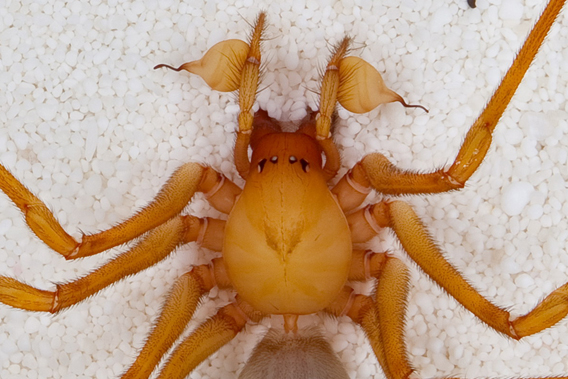
A better look at the head. Photo by Griswold CE, Audisio T, Ledford JM.
Scouring the caves of Southwest Oregon, scientists made an incredible discovery of a fearsome apex predator with massive, sickle claws. It wasn’t the Velociraptor from Jurassic Park: it was a large spider that is so unique scientists were forced to create a new taxonomic family for it. It was the first new spider family to be discovered in North America in over 130 years.
The discoverers, who published the description in the open-access journal ZooKeys named the new species Trogloraptor, which translates loosely to “cave robber,” and dubbed a new spider family—Trogloraptoridae—to accommodate what they believe is a primitive spider. The full species name is Trogloraptor marchingtoni after one of its discoverers.
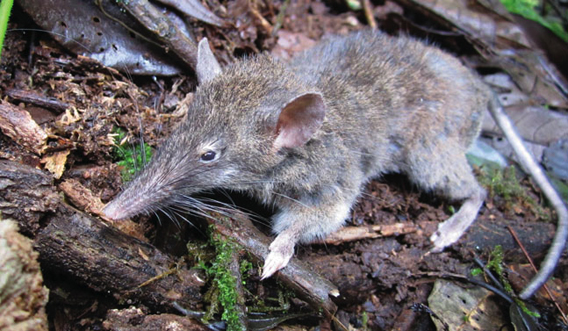
A rodent unlike any other: Paucidentomys vermidax. Photo from: Esselstyn et al.
In August scientists described Paucidentomys vermidax, an unusual new species of rodent from Sulawesi. Unlike the over 2,000 known species of rodents, the rodents lacks cheek teeth, which makes it impossible for the species to gnaw on its food. So, if the rodent is not gnawing on nuts and seeds what does it eat?
“Stomach contents from a single specimen suggest that the species consumes only earthworms,” the discoverers write in a new paper in Biology Letters. The scientists speculate that the species actually lost its gnawing incisors, which in most other rodents grow continuously, allowing it to “exploit resources that were not previously available,” i.e. earthworms or other soft-tissued prey. Sporting only two teeth, think of Paucidentomys vermidax as the geriatric of the rodent family.
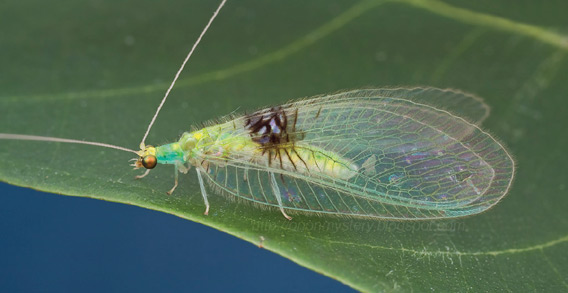
Adult green lacewing (Semachrysa jade sp. n.). Photo by Hock Ping Guek
Also in August came the news of a new species discovery based on an unusual source. Scientists discovered a previously unknown species of lacewing insect after stumbling upon a series of photos posted on Flickr®, according to a paper published in the journal ZooKeys. The species is named Semachrysa jade and lives in the rainforests of Malaysia.
Shaun Winterton, a researcher with the California State Collection of Arthropods at the California Department of Food & Agriculture, first found evidence of the species when he randomly stumbled upon a set of photos posted by Hock Ping Guek, a Malaysian photographer. Winterton recognized the insect as a potentially new species, but needed to collect field specimen in order to formally describe it. About a year later, an individual was collected at the same site, enabling Winterton and Stephen J. Brooks of the Natural History Museum in London to write up the description in ZooKeys. Hock is a co-author on the paper.
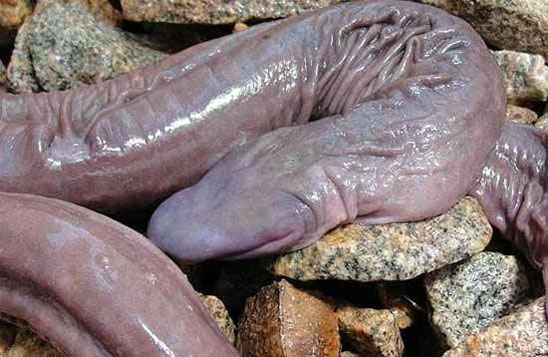
Photo by Matt Roper
While not a “new” species, an unusual creature from Brazil made international headlines when it turned up when hydrologists were draining a portion of the Madeira River, a tributary of the Amazon. The animal is Atretochoana eiselti, a type of caecilian, a limbless amphibian. Little else is known about the “penis snake” — as some have called it — although it is thought to be aquatic and lacks lungs, breathing through its skin instead. Other individuals have been found near the mouth of the Amazon, more than 2,500 km away. Atretochoana eiselti‘s population status is unknown, but the area where it was most recently discovered will soon be impacted by the Santo Antonio Dam near Porto Velho in Rondonia. Environmentalists have criticized the project, noting it will flood rainforest and require degazetting a section of national park.
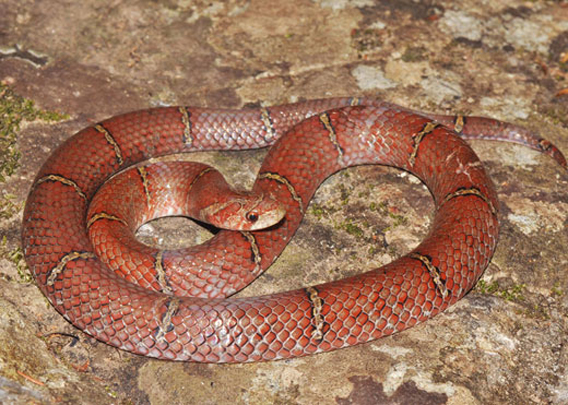
New species: the Cambodian kukri. Photo by Neang Thy/FFI.
Scientists in July described a new snake species from the biodiverse rainforests of the Cardamom Mountains. The new reddish-hued serpent has been named after its country of origin by native herpetologist Neang Thy: the Cambodian kukri (Oligodon kampucheaensis).

Freshly-collected specimens of Phallostethus cuulong. Photographed and retouched by L.X. Tran and K. Shibukawa, respectively.
In a July issue of Zootaxa researchers described a new species of “penis-headed” fish from Vietnam. The species, dubbed Phallostethus cuulong, is the 22nd known member of the Phallostethidae family, a group of tiny, otherwise non-descript fish characterized by the presence of copulatory organs just under their throat.
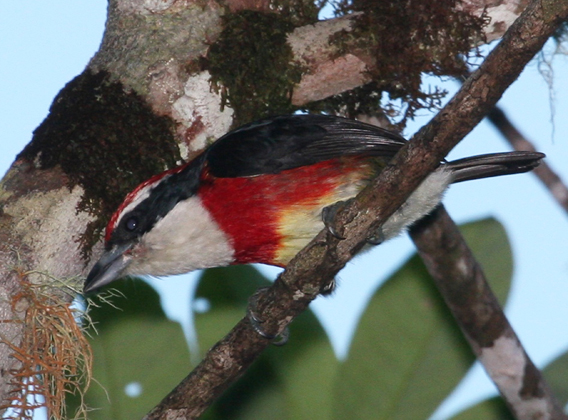
Sira barbet (Capito fitzpatricki). Photo by Michael G. Harvey.
In 2008 three recently graduated students from Cornell University discovered a never-before-recorded species of black, white, and scarlet bird in a remote cloud forest in Peru’s Cerros del Sira mountain range. In July, the species was formally described in the scientific journal The Auk. It is known as the Sira barbet (Capito fitzpatricki).
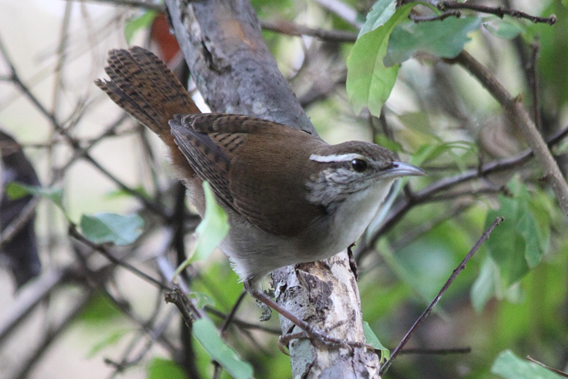
The Antioquia wren (Thryophilus sernai). Photo by Carlos Esteban Lara.
A second new species of bird was also described in the same issue of Auk. The Antioquia wren (Thryophilus sernai) was first seen in 2010 along the Cauca River in Colombia’s Ituango municipality. However, even as the species was discovered, the scientists who documented it warned it could soon be gone. An increase in mining, tourism infrastructure, and deforestation for agriculture in the region has resulted in widespread habitat loss. Moreover, none of region’s dry forest is currently protected. But the fatal blow could be the planned Pescadero-Ituango hydroelectric project.
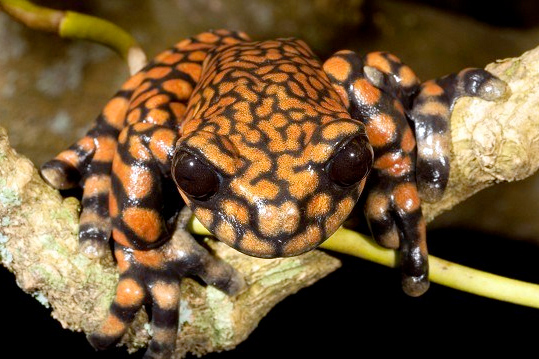
Hyloscirtus princecharlesi. Photo by Luis A. Coloma.
Also in July, herpetologists formally announced the discovery of a stunning new species of frog from highly endangered clouds forests in Ecuador. They named it Hyloscirtus princecharlesi in honor of the Prince of Wales for the royal’s work to preserve tropical forests, including his efforts to mobilize political and financial support for a program to compensate developing countries for conserving their rainforests. The species was described in Zootaxa.
Shortly after the description of Hyloscirtus princecharlesi, scientists in Berkeley announced the number of known amphibians now exceeds 7,000, or roughly 3,000 more than were known just 25 years ago.
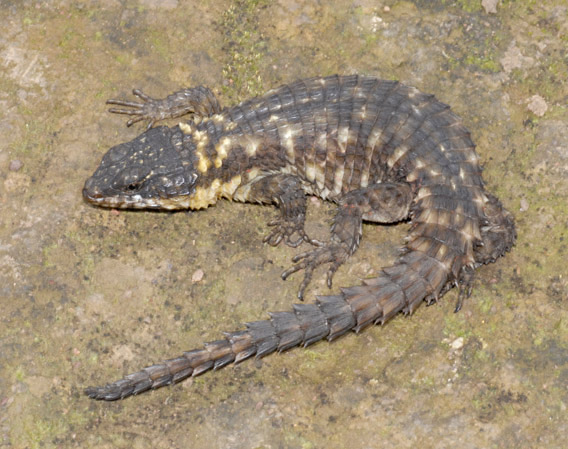
The new species of lizard, Cordylus marunguensi, from the Democratic Republic of Congo. Photo courtesy of Eli Greenbaum.
In May, scientists unveiled Cordylus marunguensi, a lizard discovered in a war-torn area of the Democratic Republic of the Congo (DRC). According to a paper in the African Journal of Herpetology, the new species was found hiding under a rock in the high grasslands of the Marungu Plateau, an area known for landmines.
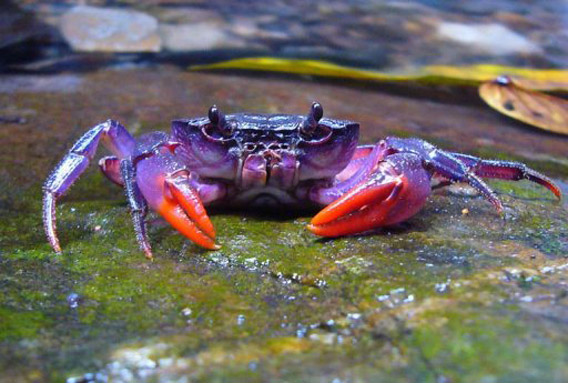
New species of purple crab: Insulamon palawanense. Photo by Hendrik Freitag.
In the April issue of the Raffles Bulletin of Zoology, scientists described four new species of brilliantly-colored freshwater crabs on the Philippine island of Palawan. Found in streams, the primarily nocturnal crabs feed on plants as well as small animals. The largest of the four new species is still quite small, its carapace spanning 5.3 centimeters, while the smallest carapace’s measures just 2.5 centimeters. The researchers theorize that the bright colors evolved for mating behavior.
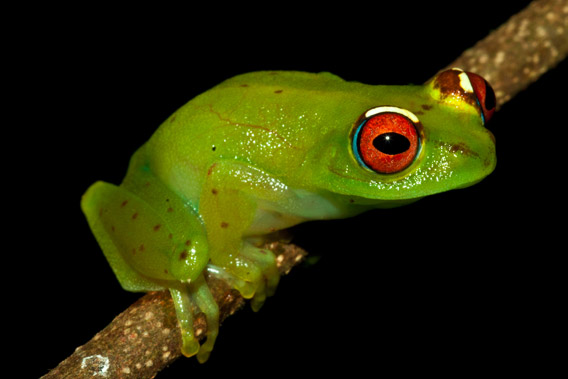
Confirmed new frog species from Betampona Forest Reserve in the Boophis genus. Photo by Gonçalo M. Rosa.
A paper published in the April issue of the journal Biodiversity Conservation announced the discovery of up to 36 previously unknown species of frogs in a forest reserve less than half the size of Manhattan. Lead author of the paper, Gonçalo M. Rosa, told mongabay.com that the reason why this forest held so many frog species “is still a mystery.” He noted that up to 24 of the species in the forest may be endemic, i.e. found no-where else in the world but in the 2,228-ha Betampona Nature Reserve in Madagascar.
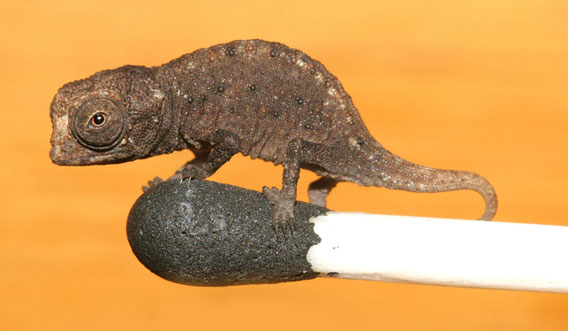
Juvenile Brookesia micra on match. Courtesy of F. Glaw et al.
In February scientists announced the discovery of four new species of super-tiny chameleons in Madagascar. The smallest of the new species, Brookesia micra, is found only on the small island of Nosy Hara and has been dubbed the smallest chameleon in the world, measuring from nose to tail 29 millimeters (1.14 inches) at its largest. Scientists believe it represents a notable example of island dwarfism. The descriptions of the new species were published in PLoS ONE.
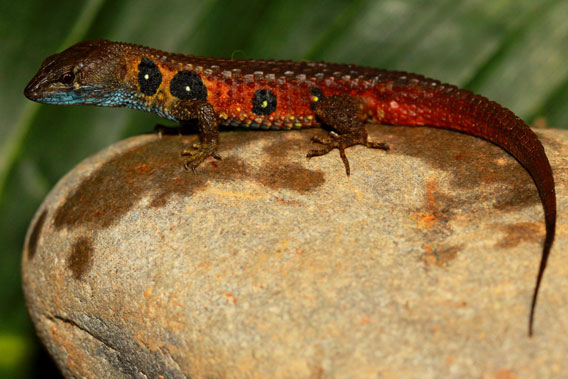
A male Potamites montanicola, a new species of lizard discovered in the Peruvian Andes. Photo courtesy of German Chávez.
In a January issue of ZooKeys, scientists described a new species of aquatic lizard from the Peruvian Andes. The species, called Potamites montanicola, is notable for the bright coloration of males. The species was discovered as a part of a biodiversity monitoring program by COGA, a Peruvian fossil fuel company.
-beyonceae-2.568.jpg)
Scaptia beyonceae. Photo by Bryan Lessard, CSIRO.
In January, singer and performer Beyoncé was accorded with a new honor: entomologists in Australia named a new horse fly after her. The horse fly, dubbed Scaptia beyonceae, is found in Queensland’s Atherton Tablelands.
 Microcebus gerpi. Photo by Blanchard Randrianambinina |
And finally, in January, primatologists writing in the journal Primates declared a new species of mouse lemur from Madagascar. The diminutive primate is named Gerp’s mouse lemur (Microcebus gerpi) after a GERP (Groupe d’Étude et de Recherche sur les Primates de Madagascar), a local lemur research group. It was discovered during surveys in 2008 and 2009 in Sahafina Forest, a fragment of rainforest just 50 km away from the well-known Mantadia National Park, which lies east of Madagascar’s capital city of Antananarivo. The lemur was confirmed as a “new species” after genetic analysis of small biopsies collected during the surveys. Lemurs were not killed to make the determination that it was an undescribed species.









-beyonceae-2.568.jpg)












